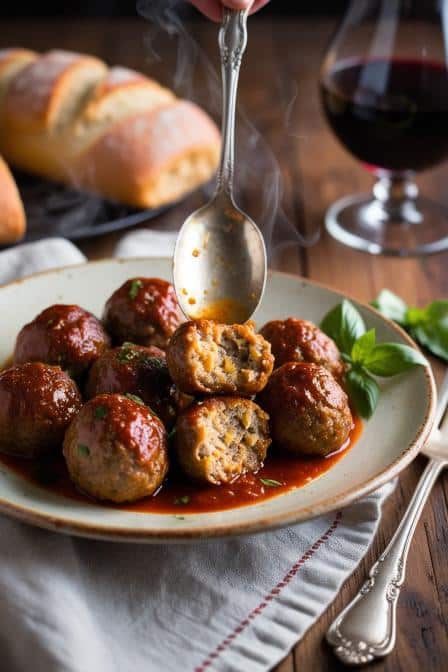Let me tell ya somethin’—once, in the back of a tiny Roman trattoria, I watched an old nonna roll meatballs softer than clouds. Her hands, gnarled from decades of dough and sauce, moved with a grace I still can’t mimic. And right then, I got it: meatballs ain’t just food—they’re memory, family, and stubborn love all packed into tender orbs. Funny thing, huh?
See, classic Italian meatballs are a contradiction. Humble yet decadent. Rustic yet refined. They whisper stories of Sunday tables heavy with Chianti and laughter, and they shout loud with garlic, Pecorino, and San Marzano tomatoes. What makes ’em special? It’s not only the mix of beef and pork, but the fresh herbs, the proper breadcrumb soak, and the simmering—long, patient, borderline obsessive simmering—that coaxes out that soul-warming richness.
Ingredients & Substitutions
You’d think it’s simple: meat, egg, breadcrumb, cheese, herbs. But oh, the devil dances in the details. Look closer:
| Ingredient | Why it matters | Substitutions / Tips |
|---|---|---|
| Ground beef (80/20) | Fat keeps meatballs juicy | Use turkey for leaner; bison for gamier |
| Ground pork | Adds sweetness, softer texture | All beef works, but misses subtle sweetness |
| Eggs | Bind the mix gently | Flaxseed meal + water if vegan |
| Fresh breadcrumbs | Soak in milk for tenderness | Panko, gluten-free crumbs, or leftover focaccia |
| Whole milk | Softens crumbs | Almond milk works if dairy-free |
| Pecorino Romano | Salty tang | Parmesan, Grana Padano |
| Fresh parsley & basil | Herbaceous lift | Dried herbs, but double quantity |
| Garlic (fresh, minced) | Depth and warmth | Garlic confit for milder sweetness |
| Salt & pepper | Essential seasoning | Sea salt flakes add subtle crunch |
| Olive oil | For browning | Avocado oil if neutral preferred |
| San Marzano tomatoes | Classic sauce base | Crushed plum tomatoes, but add pinch sugar |
Fresh vs. dried herbs? Fresh wins for aroma. Dried can step in—but toss ’em in earlier so they bloom in the sauce. And please, please don’t skip soaking the breadcrumbs—it’s what stops you from ending up with rubber bullets instead of velvet bites.
Step-by-Step Instructions
Alright, sleeves up. This ain’t fast food—it’s a slow dance.
1. Prep your breadcrumbs.
Soak ‘em in milk till soggy but not soup. Squeeze lightly. Keeps the meatballs tender, almost pillow-like.
2. Mix, don’t mash.
Combine meats, soaked crumbs, eggs, cheese, herbs, garlic, salt, pepper. Use your hands. Gently fold—don’t knead like dough or you’ll get dense, grumpy meatballs.
3. Shape.
Scoop golf-ball size. Roll quick, not tight. Too tight, they dry out. Too loose, they crumble. Little paradox there, huh?
4. Brown.
Heat olive oil in a heavy skillet. Brown on all sides till golden, maybe five minutes. Don’t fully cook inside—they’ll finish in sauce. Resist the urge to poke ‘em around.
5. Simmer in sauce.
Add to simmering tomato sauce. Spoon sauce gently over. Cook 30–40 min, lid slightly ajar. They’ll soak up sauce and give flavor back.
Expert tips?
- Wet hands to roll, stops sticking.
- Taste-test a mini patty before rolling the whole batch—adjust seasoning early.
- For spicier meatballs, add chili flakes or a dash of Calabrian chili paste.
Common mistake? Overmixing. It murders texture. Another? Cooking ‘em fully in the pan—they’ll dry out before the sauce has its say.
Cooking Techniques & Science
Ever wondered why we brown first? It’s the Maillard reaction—fancy science term for browning proteins and sugars. Adds deep, savory, roasted notes that boiling alone can’t touch.
Simmering low and slow in tomato sauce? Collagen in pork breaks down, turning into gelatin. That’s why meatballs feel rich on the tongue. Sauce thickens, flavors marry—romantic, if you think about it.
Tools matter too.
- Heavy skillet or Dutch oven holds heat evenly, avoids burnt bottoms.
- Slotted spoon keeps delicate balls whole when transferring.
- Wooden spoon instead of metal, so you don’t crush ‘em stirring.
Storing & reheating?
Cool, then chill meatballs in sauce in an airtight container. Keeps 3–4 days. For longer, freeze in single layers. Reheat gently on the stove or in oven—microwave’s fine but might toughen them up a tad.
Variations?
- All beef, for old-school New York style.
- Swap pork for spicy Italian sausage for bolder kick.
- Vegan? Use lentils + mushrooms, flax eggs, and almond milk-soaked crumbs.
- Gluten-free? Rice crumbs or cornmeal.
Serving & Pairing Suggestions
Plate matters. Wide, shallow bowl cradles sauce, shows off meatballs.
Serve over:
- Spaghetti or rigatoni, classic as Sinatra.
- Creamy polenta, pure comfort.
- Toasted ciabatta for sauce-mopping.
Drizzle extra virgin olive oil, scatter basil ribbons, grate more Pecorino.
Drink? Chianti Classico, medium body, enough acidity to cut richness. Or even Barbera, fruity and bright.
Sides?
- Bitter greens salad with lemony dressing.
- Grilled zucchini with olive oil.
- A chunk of crusty bread.
Best Time to Serve or Eat
Sunday lunch. It’s tradition, sure—but also the slowest time of the week. Meatballs need simmering, and Sunday grants that kindness. Or serve ‘em at gatherings; they feed crowds, stay warm in sauce, and invite second helpings.
Leftovers on Monday? Even better—the sauce deepens overnight. Funny, right? Like stew, they’re tastier the day after.
Conclusion
Classic Italian meatballs aren’t just “balls of meat.” They’re practice, patience, and love. They teach restraint: don’t overmix, don’t rush the simmer, don’t skip fresh herbs. They forgive too—you can tweak meats, swap herbs, play with spice.
Final tip? Cook with someone else. Pass the rolling between hands, argue over sauce thickness, taste together. Cooking alone fills the belly. Cooking together fills something deeper.
FAQs
1. Can I bake instead of fry?
Sure—400°F for about 20 min, then finish simmering in sauce. Less mess, slightly firmer crust.
2. Why do mine fall apart?
Likely too little binder (egg or crumbs) or over-soaked crumbs left too wet. Squeeze crumbs gently before mixing.
3. Can I freeze uncooked meatballs?
Yes. Freeze on a tray first so they don’t clump, then store in bags. Cook from frozen—just add a few minutes to simmer time.
4. What if sauce feels acidic?
Pinch of sugar or splash of milk. Or, my nonna’s trick: half a grated carrot into the sauce as it simmers.
5. Best cheese: Parmesan or Pecorino?
Depends. Pecorino’s sheepier, saltier; Parmesan’s nuttier, milder. I say blend ‘em. Layers of flavor never hurt.
And that’s it. Classic Italian meatballs—more than just a recipe, they’re an edible story passed down, rolled by hand, simmered with care. So go on—roll, simmer, taste. And maybe, just maybe, you’ll taste history too.

